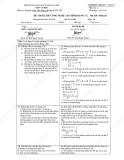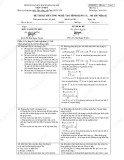
REGULAR ARTICLE
A stochastic method to propagate uncertainties along large cores
deterministic calculations
Ludovic Volat
*
, Bernard Gastaldi, and Alain Santamarina
CEA, DEN, DER, SPRC, Cadarache, 13108 Saint-Paul Les Durance, Cedex, France
Received: 10 November 2017 / Received in final form: 13 February 2018 / Accepted: 4 May 2018
Abstract. Deterministic uncertainty propagation methods are certainly powerful and time-sparing but their
access to uncertainties related to the power map remains difficult due to a lack of numerical convergence. On the
contrary, stochastic methods do not face such an issue and they enable a more rigorous access to uncertainty related
to the PFNS. Our method combines an innovative transport calculation chain and a stochastic way of propagating
uncertainties on nuclear data: first, our calculation scheme consists in the calculation of assembly self-shielded cross
sections and a pin-by-pin flux calculation on the whole core. Validation was done and the required CPU time is
suitable to allow numerous calculations. Then, we sample nuclear cross sections with consistent probability
distribution functions with a correlated optimized Latin Hypercube Sampling. Finally, we deduce the power map
uncertainties from the study of the output response functions. We performed our study on the system described in
the framework of the OECD/NEA Expert Group in Uncertainty Analysis in Modelling. Results show the
238
U
inelastic scattering cross section, the
235
U PFNS, the elastic scattering cross section of
1
H and the
56
Fe cross sections
as major contributors to the total uncertainty on the power map: the power tilt between central and peripheral
assemblies using COMAC-V2 covariance library amounts to 5.4% (1s) (respectively 7.4% (1s) using COMAC-V0).
1 Introduction
1.1 Context: GEN-III cores
The improvements in reactor technology of the so-called
GEN-III reactors are intended to result in a longer
operational lifetime (at least 60 years) compared with
currently used GEN-II reactors (designed for 40 years of
operation). In particular, they take advantage from a
simpler and more rugged design, making them easier to
operate and less vulnerable to operational upsets. From a
neutronic point of view, a higher burn-up is aimed to reduce
fuel consumption as well as the amount of corresponding
waste. More specifically, we will study advanced GEN-III
cores which are bigger than current PWRs and character-
ized by a heavy reflector.
1.2 Objectives
Whilst powerful and timesparing methods have been
largely used to propagate uncertainties in core calculations
[1], a great endeavour is made to brush up on brute force
methods. Actually, thanks to growing calculation means,
stochastic methods become more attractive to calculate the
uncertainty introduced by simulation codes [2]. These
methods consist in taking into account the uncertainties
either from the very beginning of the calculation chain [3,4]
by sampling nuclear model parameters or by sampling
nuclear cross sections with consistent probability distribu-
tion [5,6] for burn-up calculations [7], for the TMI core
power map calculations [8] with different uncertainty
propagation systems [9,10]. Having regard to the nuclear
model parameters uncertainty ranges one can produce
random nuclear data evaluation (for example with TALYS
[11]). Finally, the uncertainties are deduced from the study
of the output distribution functions of interest.
Here, we propose a similar method which combines an
innovative calculation chain and a stochastic way of
propagating uncertainties on nuclear data. Given that large
cores are more sensitive to a modification of the neutronic
balance (for example, a local modification of the moderator
properties), the uncertainties associated with calculation
parameters are worth studying. We propose then here to
propagate uncertainties due to nuclear data on LWR key
parameters such multiplication factor and core power map.
1.3 Theoretical background
The Boltzmann equation, which translates the neutron
balance in a nuclear reactor, can be written in a compact
form as
A0l0F0
ð Þ’0¼0;ð1Þ
*e-mail: ludovic.volat@cea.fr
EPJ Nuclear Sci. Technol. 4, 12 (2018)
©L. Volat et al., published by EDP Sciences, 2018
https://doi.org/10.1051/epjn/2018015
Nuclear
Sciences
& Technologies
Available online at:
https://www.epj-n.org
This is an Open Access article distributed under the terms of the Creative Commons Attribution License (http://creativecommons.org/licenses/by/4.0),
which permits unrestricted use, distribution, and reproduction in any medium, provided the original work is properly cited.

where A
0
is the disappearance operator, F
0
the neutron
production operator, ’
0
is the unperturbed neutron flux
and l
0
= 1/k
0
with k
0
the first eigenvalue associated with
the fundamental mode flux ’
0
. Theoretical arguments lead
to express a perturbed flux sensitivity coefficient a
1
as
following [12]:
a1¼1
l1l0
|{z}
¼EV S
⟨’†
1jl0dFdAð Þ’0⟩
⟨’†
1jF0’1⟩;ð2Þ
where l
1
= 1/k
1
is the inverse of the first harmonic
eigenvalue of the flux, ’the neutron flux and ’
†
the
adjoint neutron flux. While the scalar product is dependent
on the external perturbation only, the first term is directly
related to the size of the core. 1=ðl1l0Þis called the
eigenvalue separation factor (EVS) and grows like the size
of the core. Thus with the same initial perturbation, the
larger the core, the higher the resulting flux perturbation
amplitude. The deterministic nuclear data uncertainty
propagation on a manifold sample of french PWRs (from
900 MWe to 1700 MWe) showed that the central assembly
power uncertainty increases from 1.5% to 4% (1s) [13]
mainly due to the uncertainty on
238
U inelastic scattering
cross section.
2 The core calculation scheme
2.1 Physical model
Our model is based on a realistic pattern proposed in the
framework of the Uncertainty Analysis in Modelling Expert
Group of the OECD/NEA [14]. An international numerical
benchmark has been proposed to study the uncertainties
related to large cores: a fresh core with 241 assemblies, each
of them containing 265 pins at hot zero power (HZP). Under
these operating conditions, no thermohydraulics feedback
flattens the power map. Thus the HZP radial power
uncertainty is expected to reach its maximum.
A whole 2D core calculation is undertaken, with a
refined pin description and a flux calculation scheme in two
steps. First, each individual assembly geometry in an
infinite lattice is described. After that, self-shielded 281
SHEM [15] energy groups cross sections are produced.
Then, the neutron flux is calculated thanks to the method
of characteristics onto the whole geometry. Even though
the computational power has been steadily growing with
time, yet the CPU time needed in order to have flux
convergence is still too high. That is why several
assumptions are made in order to reduce CPU time cost.
Given that the steady state Boltzmann equation is
discretized in space and energy, we decided to vary the
calculation parameters from APOLLO2.8 reference calcu-
lation scheme used at CEA [16]:
– We present in Figure 1 the spatial mesh of our study. The
interface between the reflector and the peripheral
assembly has been finely meshed to keep a good
description of the impact of the reflector on the power
map. Due to this refinement, the distance between each
characteristic was settled to Dr= 0.04 cm.
– We used a 20 groups energy mesh [16] (cf. Tab. 1) instead
of 26 groups [16]: we removed the six groups devoted to
the description of the
240
Pu 1 eV resonance, that is not
needed in LWR-UOx cores.
– In order to obtain an accurate neutron migration in the
core, a P3 Legendre expansion was used to describe the
anisotropic scattering.
Our method allowed to reduce the CPU cost for a pin-
by-pin transport core calculation from 1 day to 1 h, on a
single Intel 3 GHz processor with 11Go of RAM use.
3 The cross section sampling method
The values of our input nuclear data are assumed to be
described by a Gaussian distribution with the standard
deviation given by the covariance library. Given that the
number of calculations is limited, the population of our
statistical sample must be small. This so-called design of
experiments must be wisely chosen in order to fulfill the
three following properties : optimal covering of the input
parameter space, robustness of projections over 2D
subspaces and sequentiality. Now, we will show that the
Latin hypercube sampling (LHS) is the optimum fitting to
our need. The LHS comes down to equally chop off all the
dimensions, and thus make sub-intervals of equal bin
width. Each sampling point coordinate is the only one in
each sub-interval. To get the best compromise between a
not large confidence interval and a limited population, we
chose a population of 50 with a L2-star optimized LHS [17].
Once we sampled each cross section in each energy group as
a Gaussian Nð0;1Þ(the corresponding vector is noted X),
covariance libraries have to be taken into account. This was
made by using a single value decomposition. Here we note
the covariance matrix C, the dimension of our problem d,
the vector containing all the means m. We are looking for a
multivariate Gaussian vector Y∈ ℝ
d
, whose probability
density function (pdf) is Nðm;CÞ. Let us note Y=QX+m.
The problem is actually equivalent to choose Qso that
EððYmÞðYmÞTÞ ¼ C. We took eventually Qas Q=
PD
1/2
where Dis the eigenvalues diagonal matrix of Cand
Pthe corresponding transfer matrix. In the framework
composed by the eigenvectors, the linear application
Fig. 1. Spatial core mesh: interface between the peripheral
assemblies and the heavy reflector.
2 L. Volat et al.: EPJ Nuclear Sci. Technol. 4, 12 (2018)

corresponding to D
1/2
is a dilatation of the distribution and
Pcorresponds to a rotation. Then the distribution is shifted
by m.
4 Results
The cross-section values calculated after the self-shielding
step are modified according to Y. Then, for each sampling,
our calculation routine is run. Finally we study the final
distribution function of the multiplication factor and the
one of the assembly power map in order to deduce the
related uncertainties. The Gaussian output function is
infered by fitting the probability plot, as shown in Figure 2.
For this work, we chose to use two sets of covariances
matrices taken from COMAC: the first one, called here
COMAC-V0 [18], was released in 2012 and the second one,
called COMAC-V2 contains major results obtained until
2016 [19,20]. Thus we compare the impact of the two
covariance libraries on the power map and highlight how
the library change has contributed to reduce the
contribution of several major isotopes to the total
uncertainty. Table 2 spots the seven major contributions
to the total uncertainty on the k
eff
, the center of the power
map, and the peripheral assemblies.
235
Uxand
238
U (n,n’)
contain the highest uncertainties of the power map.
By combining quadratically the major contributions,
we obtain for the k
eff
a total uncertainty of 669 pcm. On the
plus side, we decided to take into account more correlations
between cross sections thanks to a dedicated design of
experiments for the total uncertainty. So, the correspond-
ing uncertainty raises up to 688 pcm.
Concerning the center of the power map and the outer
ring of assemblies these total uncertainties stand respec-
tively for 4.2% and 3.2%.
Similarly, Table 3 presents the last results obtained
with the new covariance library, COMAC-V2:
– The contribution due to the
238
U fission cross section has
dramatically been reduced: above 1 MeV, the standard
deviation in COMAC-V2 is around 2%–3%, the same
order of magnitude as the standards. That leads to a
reduction of its contribution by a factor of 4 on the k
eff
.
– Concerning the contribution of the inelastic cross section
of
238
U: in COMAC-V0, the uncertainty value on the
plateau is around 10%.
In COMAC-V2, the uncertainty value above the
threshold has been strongly reduced to 5%–6%. However,
we assume this value to be optimistic. For further
calculations, we propose an uncertainty level of 15% on
the plateau. This would include an overestimation of the
cross section value in JEFF-3.1.1 by 10% on the plateau.
Even so, we point out that these values stay much lower
than the ones given example by ENDF/BVII.1 (30%).
– The contribution of the
235
U PFNS uncertainty has been
reduced from COMAC-V0 to COMAC-V2: the level of
the input uncertainty has been reduced by more than a
factor of 2 on the whole energy range, reducing
drastically the uncertainty on the power map.
– Interesting is the contribution of the iron scattering in
the power map uncertainty. Given that most of the iron is
contained in the heavy reflector, an increase of the iron
scattering cross section will enhance the ability of the
reflector to send back neutrons in the core. Then, at the
periphery of the core more neutrons will be moderated
and more fissions will occur. Finally, this will add a radial
swing to the power map. That is why this cross section
Table 1. Description of the 20 groups energy mesh.
Group Energy upper
bound
Comments
1 19.64 MeV (n,2n) and 2nd chance fission
2 4.490 MeV Fast domain
3 2.231 MeV First resonance of
16
O
4 1.337 MeV
5 494 eV
6 195 keV
7 67.38 keV
8 25 keV
9 9.12 keV Unresolved domain
10 1.91 keV
11 411 eV Resolved resonances
12 52.67 eV 3 first resonances of
238
U
13 4.000 eV
240
Pu &
242
Pu resonances
14 625 MeV
15 353 MeV Resonances of
239
Pu
16 231.2 MeV
17 138 MeV
18 76.5 MeV Purely thermal domain
19 34.4 MeV
20 10.4 MeV
Fig. 2. Probability plot to deduce the uncertainty related to the
k
eff
for the contribution of
238
U (n,f) with COMAC-V0.
L. Volat et al.: EPJ Nuclear Sci. Technol. 4, 12 (2018) 3

held a lot of attention with the PERLE program [21,22]
which helped to produce the covariances included in
COMAC V0.
Finally, Figure 3 presents the whole uncertainty map
on our core. It clearly shows the radial swing between the
centre and the outer ring of assemblies.
Table 2. Main contributors and total propagated uncertainty (1s) with COMAC-V0.
Contributor rank unc. k
eff
pcm unc. P
center
std unc. P
periph.ass.
std
1
238
U (n,f) 409
235
Ux2.4%
235
Ux2.0%
2
238
U (n,g) 312
238
U (n,n’) 2.0%
238
U (n,n’) 1.5%
3
235
Un273
1
H (n,n) 1.2%
1
H (n,n) 1.1%
4
235
Ux215
56
Fe (n,n) 0.7%
56
Fe (n,n) 0.8%
5
235
U (n,f) 147
235
U (n,g) 0.3%
238
U (n,f) 0.4%
6
235
U (n,g) 143
238
U (n,g) 0.3%
238
U (n,g) 0.3%
7
1
H (n,g) 141
1
H (n,g) 0.3%
1
H (n,g) 0.3%
Total uncertainty k
eff
688 Pcenter 4.2% Pperiph:ass:3.2%
Table 3. Main contributors and total propagated uncertainty (1s) with COMAC-V2.
Contributor rank unc. k
eff
pcm unc. P
center
std unc. P
periph.ass.
std
1
238
U (n,f) 277
1
H (n,n) 1.3%
1
H (n,n) 1.1%
2
238
U (n,g) 248
235
Ux1.0%
235
Ux1.0%
3
235
U (n,g) 145
238
U (n,n’) 1.0%
238
U (n,n’) 0.8%
4
235
U (n,f) 144
56
Fe (n,n) 0.8%
56
Fe (n,n) 0.8%
5
1
H (n,g) 132
235
U (n,g) 0.3%
235
U (n,g) 0.2%
6
238
U (n,f) 116
1
H (n,g) 0.3%
1
H (n,g) 0.2%
7
235
Ux103
238
U (n,g) 0.3%
238
U (n,g) 0.2%
Total uncertainty k
eff
634 Pcenter 3.1% Pperiph:ass:2.3%
Fig. 3. Normalized power map with uncertainties (1s) underneath with COMAC-V0.
4 L. Volat et al.: EPJ Nuclear Sci. Technol. 4, 12 (2018)

5 Summary and conclusions
We proved that uncertainties on light water reactors
parameters due to nuclear data can be propagated through
a brute force method thanks to modern computation
power. This method gives access to all of the needed
uncertainties without developing any dedicated perturba-
tion theory or using special hypothesis.
We applied this method to our PWR large core NEA
benchmark and showed that the overall k
eff
uncertainty
reaches 634 pcm, 3.1% for the centre of the power map and
2.3% for the outer ring of assemblies, thus a potential
power swing of ± 5.4% (1s). The main contributors are n,
the capture and fission cross sections of
235
U, the capture
cross section of
238
U for the k
eff
. Inelastic scattering cross
section of
238
U, PFNS of
235
U, elastic scattering cross
section of
56
Fe and
1
H are the main contributors to the
assembly power map uncertainty.
This method could be applied to propagate other
uncertainties, especially design and technological uncer-
tainties, whose analytical expressions are difficult to derive
with the usual perturbation theory.
The authors would like to thank CEA's industrial partners
Electricité de France and AREVA for their financial support to
this work.
References
1. A. Gandini, A generalized perturbation method for bi-linear
functionals of the real and adjoint neutron fluxes, J. Nucl.
Energy 21, 755 (1967)
2. N. García-Herranz, O. Cabellos, J. Sanz, J. Juan, J.C.
Kuijper, Propagation of statistical and nuclear data
uncertainties in Monte Carlo burn-up calculations, Ann.
Nucl. Energy 35, 714 (2008)
3. A.J. Koning, D. Rochman, Towards sustainable nuclear
energy: putting nuclear physics to work, Ann. Nucl. Energy
35, 2024 (2008)
4. P. Sabouri, A. Bidaud, S. Dabiran, D. Lecarpentier, F.
Ferragut, Propagation of nuclear data uncertainties in
deterministic calculations: application of generalized pertur-
bation theory and the total monte carlo method to a PWR
burnup pin-cell, Nucl. Data Sheets 118, 523 (2014)
5. W. Zwermann, B. Krzykacz-Hausmann, L. Gallner, A.
Pautz, M. Mattes, Uncertainty analyses with nuclear
covariance data in reactor core calculations, J. Korean Phys.
Soc. 59, 1256 (2011)
6. A. Hernandez-Solís, Uncertainty and Sensitivity Analysis
Applied to LWR Neutronic and Thermal-Hydraulic Calcu-
lations. Ph.D. thesis, Chalmers University of Technology,
Sweden, 2012
7. C.J. Díez, O. Buss, A. Hoefer, D. Porsch, O. Cabellos,
Comparison of nuclear data uncertainty propagation meth-
odologies for PWR burn-up simulations, Ann. Nucl. Energy
77, 101 (2015)
8. K. Zeng, J. Hou, K. Ivanov, M.A. Jessee, Uncertainty
Analysis of Light Water Reactor Core Simulations Using
Statistic Sampling Method, in M&C 2017 (Jeju, Korea, 2017)
9. O. Cabellos, E. Castro, C. Ahnert, C. Holgado, Propagation
of nuclear data uncertainties for PWR core analysis, Nucl.
Eng. Technol. 46, 299 (2014)
10. M. Klein, L. Gallner, B. Krzykacz-Hausmann, A. Pautz, W.
Zwermann, Influence of nuclear data uncertainties on reactor
core calculations, Kerntechnik 76, 174 (2011)
11. A.J. Koning, D. Rochman, Modern nuclear data evaluation with
the TALYS code system, Nucl. Data Sheets 113, 2841 (2012)
12. A. Sargeni, K.W. Burn, G.B. Bruna, The impact of heavy
reflectors on power distribution perturbations in large PWR
reactor cores, Ann. Nucl. Energy 94, 566 (2016)
13. A. Santamarina, P. Blaise, N. DosSantos, C. Vaglio-
Gaudard, C. De Saint Jean, Nuclear data uncertainty
propagation on power maps in large LWR cores, in JAEA-
Conf–2014-003, Japan, 2015
14. K. Ivanov, M. Avramova, S. Kamerow, Benchmarks for
uncertainty analysis in modelling (UAM) for the design,
operation and safety analysis of LWRs, volume 1: Specifica-
tion and Support Data for Neutronics Cases (Phase I).
OECD, NEA, May 2013
15. N. Hfaiedh, A. Santamarina, Determination of the optimised
SHEM mesh for neutron transport calculation, in Proc. Int.
Conf. on Mathematics and Computation,2005
16. A. Santamarina, D. Bernard, P. Blaise, P. Leconte, J.-M.
Palau, B. Roque, C. Vaglio, J.-F. Vidal, Validation of the
New Code Package APOLLO2.8 for Accurate PWR
Neutronics Calculations, Sun Valley, Idaho, USA, 2013
17. G. Damblin, M. Couplet, B. Iooss, Numerical studies of space-
filling designs: optimization of Latin Hypercube Samples and
subprojection properties, J. Simul. 7, 276 (2013)
18. C. De Saint Jean, Estimation of multi-group cross section
covariances for
235,238
U,
239
Pu,
241
Am,
56
Fe,
23
Na and
27
Al, in
PHYSOR 2012,Knoxville, Tenessee, USA, April 2012
19. L. Berge, Contribution à la modélisation des spectres de
neutrons prompts de fission. Propagation d’incertitudes sur un
calul de fluence cuve. Ph.D. thesis, Université Grenoble-Alpes,
Grenoble, 2015
20. N. Terranova, Covariance Evaluation for Nuclear Data
Interest to the Reactivity Loss Estimatio of the Jules
Horowitz Material Testing Reactor. PhD thesis, Università
di Bologna, Bologne, 2016
21. C. Vaglio-Gaudard, A. Santamarina, P. Blaise, O. Litaize, A.
Lyoussi, G. Noguère, J.M. Ruggieri, J.F. Vidal, Interpretation
of PERLE experiment for the validation of iron nuclear data
using monte carlo calculations, Nucl. Sci. Eng. 166, 89 (2010)
22. C. Vaglio-Gaudard, A. Santamarina, G. Noguère, J.M.
Ruggieri, J.-F. Vidal, A. Lyoussi, New 56 Fe covariances for
the JEFF3 file from the feedback of integral benchmark
analysis, Nucl. Sci. Eng. 166, 267 (2010)
Cite this article as: Ludovic Volat, Bernard Gastaldi, Alain Santamarina, A stochastic method to propagate uncertainties along
large cores deterministic calculations, EPJ Nuclear Sci. Technol. 4, 12 (2018)
L. Volat et al.: EPJ Nuclear Sci. Technol. 4, 12 (2018) 5










![Đề thi Công nghệ tạo hình dụng cụ năm 2020-2021 - Đại học Bách Khoa Hà Nội (Đề 4) [Kèm đáp án]](https://cdn.tailieu.vn/images/document/thumbnail/2023/20230130/phuong62310/135x160/3451675040869.jpg)







![Ngân hàng trắc nghiệm Kỹ thuật lạnh ứng dụng: Đề cương [chuẩn nhất]](https://cdn.tailieu.vn/images/document/thumbnail/2025/20251007/kimphuong1001/135x160/25391759827353.jpg)







